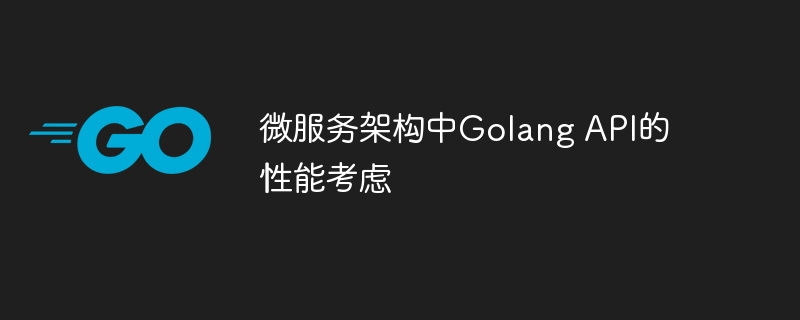Go API のパフォーマンスを最適化するには、次のことをお勧めします: 1. 静的ファイル キャッシュ メカニズムを使用する; 2. パフォーマンスのボトルネックを発見して解決するために、分散トレース メカニズムを使用してリクエスト処理プロセスを追跡する。これらのテクノロジは、レイテンシを効果的に短縮し、スループットを向上させることができるため、マイクロサービス アーキテクチャの全体的なパフォーマンスと安定性が向上します。

マイクロサービス アーキテクチャにおける Go API のパフォーマンスの最適化
はじめに
マイクロサービス アーキテクチャにおけるパフォーマンス重要です。この記事では、さまざまな手法を使用して Go API のパフォーマンスを最適化し、レイテンシーを短縮し、スループットを向上させる方法に焦点を当てます。
コード例
静的ファイル キャッシュ
// ./handlers/cache.go
package handlers
import (
"net/http"
"time"
"github.com/go-cache/go-cache"
)
// Cache is an in-memory cache.
var Cache = cache.New(5*time.Minute, 10*time.Minute)
// CacheRequestHandler is a middleware that caches HTTP responses.
func CacheRequestHandler(next http.Handler) http.Handler {
return http.HandlerFunc(func(w http.ResponseWriter, r *http.Request) {
// Check if the response is already cached.
if cachedResponse, found := Cache.Get(r.URL.Path); found {
// If found, serve the cached response.
w.Write(cachedResponse.([]byte))
return
}
// If not found, call the next handler.
next.ServeHTTP(w, r)
// Cache the response for future requests.
Cache.Set(r.URL.Path, w, cache.DefaultExpiration)
})
}// ./main.go
package main
import (
"fmt"
"net/http"
"github.com/gorilla/mux"
"./handlers"
)
func main() {
r := mux.NewRouter()
// Add middleware to cache static file responses.
r.Use(handlers.CacheRequestHandler)
}分散トレース
// ./handlers/trace.go
package handlers
import (
"context"
"fmt"
"net/http"
"github.com/opentracing/opentracing-go"
"github.com/opentracing/opentracing-go/ext"
)
func TracesHandler(w http.ResponseWriter, r *http.Request) {
// Create a new span for this request.
span, ctx := opentracing.StartSpanFromContext(r.Context(), "traces")
// Add some tags to the span.
ext.HTTPMethod.Set(span, r.Method)
ext.HTTPUrl.Set(span, r.RequestURI)
// Simulate work being done.
fmt.Fprintln(w, "Hello, traces!")
// Finish the span.
span.Finish()
}// ./main.go
package main
import (
"fmt"
"net/http"
"github.com/gorilla/mux"
"github.com/opentracing/opentracing-go"
"github.com/uber/jaeger-client-go"
"github.com/uber/jaeger-client-go/config"
)
func main() {
// Configure and initialize Jaeger tracer.
cfg := &config.Configuration{
ServiceName: "go-api",
}
tracer, closer, err := cfg.NewTracer()
if err != nil {
panic(err)
}
defer closer.Close()
opentracing.SetGlobalTracer(tracer)
r := mux.NewRouter()
// Add route that uses tracing.
r.HandleFunc("/traces", handlers.TracesHandler)
}結論
これらのパフォーマンス最適化手法を実装することで、Go API をマイクロサービス アーキテクチャで効率的に実行できるようになり、ユーザーの満足度と全体的なシステム パフォーマンスが向上します。
以上がマイクロサービス アーキテクチャにおける Golang API のパフォーマンスに関する考慮事項の詳細内容です。詳細については、PHP 中国語 Web サイトの他の関連記事を参照してください。